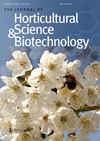一年制生产系统中温度和降雨对芦笋茎出苗和生长的影响
IF 2.1
4区 农林科学
Q2 HORTICULTURE
Journal of Horticultural Science & Biotechnology
Pub Date : 2023-11-03
DOI:10.1080/14620316.2023.2268066
引用次数: 0
摘要
摘要新开发的芦笋种植方法包括在第一年种植幼苗,并在不让母蕨类生长的情况下收获所有新出现的矛。然而,芦笋生长随时间的变化尚不清楚。在这里,在不同的气候条件下进行了四年的栽培试验,以研究生长的时间变化。每周对植物进行监测。生长期分为适宜生长温度下的春季、秋季和夏季三个时期。春季至夏季上半期,有效茎数增加出现2 ~ 3个高峰。有效茎数在高温和降水减少期(夏季)减少,随降水增加而恢复。有效茎的数量在II期和III期后半段达到峰值。茎粗的增加主要发生在夏季。夏季高温少降水生长年份的产量与春季最大茎粗呈显著正相关。本研究结果表明,植物生长可用于资源有限的植物的害虫防治、灌溉和施肥计划。关键词:芦笋;种植后平均气温;有效茎数;降水;披露声明作者未报告潜在的利益冲突。数据可用性声明支持本研究结果的数据可根据合理要求从通讯作者Satoru Motoki处获得。补充材料本文的补充数据可在https://doi.org/10.1080/14620316.2023.2268066上在线获取本文章由计算机程序翻译,如有差异,请以英文原文为准。
Asparagus stem emergence and growth as influenced by temperature and rainfall in a one-year production system
ABSTRACTNewly developed asparagus farming involves planting seedlings in year one and harvesting all emerging spears without allowing the mother ferns to grow. However, changes in asparagus growth over time are unclear. Here, four-year cultivation trials were conducted under different climatic conditions to investigate temporal changes in growth. Plants were monitored weekly. The growing period was divided into three periods: spring and fall, both within optimum growing temperatures, and summer. Spring to the first half of summer revealed two to three peaks of increase in the number of effective stems. The number of effective stems decreased during high temperatures and decreased precipitation periods (summer), and recovered with an increase in precipitation. The number of effective stems displayed peaks during the second half of periods II and III. The increase in stem diameter mostly occurred during summer. Finally, the growing years that occurred with high temperatures and low precipitation in summer showed a significant positive correlation between the yield and maximum stem diameters in spring. The results of this study indicate that plant growth can be used to schedule pest control, irrigation, and fertiliser application for plants with limited resources.KEYWORDS: Asparagus officinalis L.Days after plantingmean air temperaturenumber of effective stemsprecipitationstem diameter AcknowledgementsWe would like to thank Editage (www.editage.com) for English language editing.Disclosure statementNo potential conflict of interest was reported by the author(s).Data availability statementThe data that support the findings of this study are available from the corresponding author, Satoru Motoki, upon reasonable request.Supplementary MaterialSupplemental data for this article can be accessed online at https://doi.org/10.1080/14620316.2023.2268066
求助全文
通过发布文献求助,成功后即可免费获取论文全文。
去求助
来源期刊
CiteScore
3.90
自引率
5.30%
发文量
67
审稿时长
3 months
期刊介绍:
The Journal of Horticultural Science and Biotechnology is an international, peer-reviewed journal, which publishes original research contributions into the production, improvement and utilisation of horticultural crops. It aims to provide scientific knowledge of interest to those engaged in scientific research and the practice of horticulture. The scope of the journal includes studies on fruit and other perennial crops, vegetables and ornamentals grown in temperate or tropical regions and their use in commercial, amenity or urban horticulture. Papers, including reviews, that give new insights into plant and crop growth, yield, quality and response to the environment, are welcome, including those arising from technological innovation and developments in crop genome sequencing and other biotechnological advances.

 求助内容:
求助内容: 应助结果提醒方式:
应助结果提醒方式:


